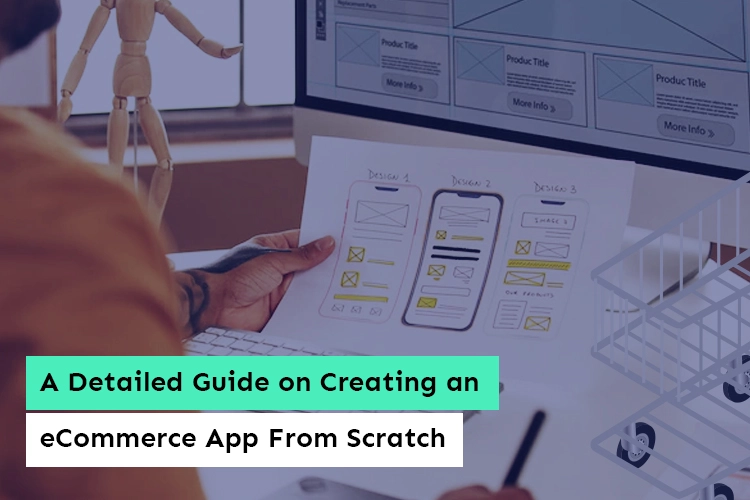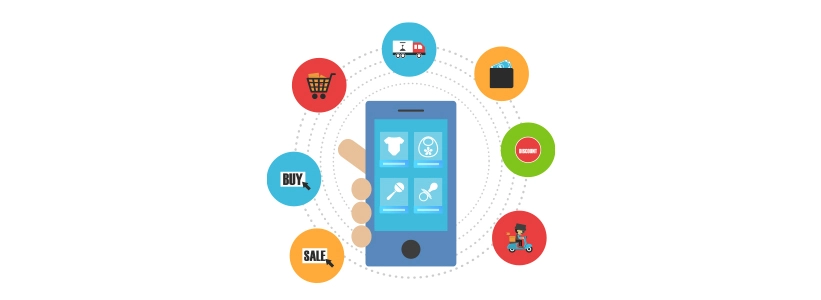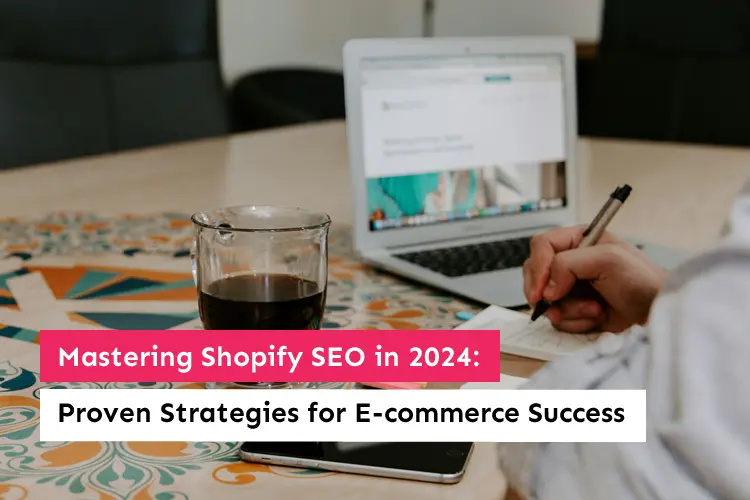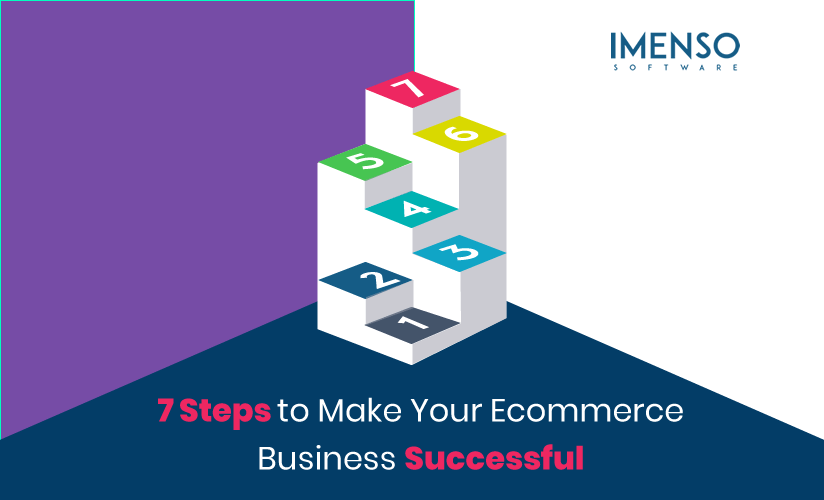A Detailed Guide on Creating an eCommerce App From Scratch

The way people shop has been drastically changed by e-commerce. In recent years, e-commerce has expanded and risen to the top in several consumer sectors. Online stores sell everything from food and apparel to electronics and vehicles. Unsurprisingly, e-commerce is a money maker for the biggest online companies in the globe.
The finest customer experience is necessary for an online store to effectively attract and retain customers. Connecting with customers at all available touchpoints and consistently providing a fantastic experience is important to do.
A seamless mobile experience is the most important factor for users. That’s because mobile sales are quickly catching up to mobile traffic, which currently makes up over 60% of all traffic. Additionally, 80% of customers who are in-store access the store’s mobile website.
Given these facts, offering a top-notch mobile experience is essential. Prioritizing and maximizing your shopping applications is necessary to conduct business online. Otherwise, you might not achieve your business goals.
But how can you create a successful mobile e-commerce app that boosts traffic, revenue, and return customers? Discover everything you need to know for creating an efficient e-commerce app from scratch. Stay along!
Why Should You Invest In an eCommerce App?
An e-commerce application can increase sales by simplifying client interaction. For instance, many e-commerce apps give businesses the ability to monitor the preferences and purchasing patterns of their customers by utilizing e-commerce modules like order monitoring, product recommendations, abandoned cart items, email marketing campaigns, etc.
1. World Of Smartphones:
As of 2022, there are 6.648 billion smartphone users worldwide, or 83.07% of the world’s population, according to statistics. A total of 7.26 billion people, or 90.72% of the world’s population, have a smartphone or feature phone. Most people use their mobile devices to perform online transactions with a single tap whenever possible, seven days a week.
2. Reduced Costs:
Your business will save money and time by using eCommerce applications instead of hiring web developers. Because e-commerce apps are so easy to use and require only a basic grasp of computers, your present staff members can create e-commerce stores!
3. Various Service Integrations:
By removing the requirement for businesses to pay for eCommerce integrations for each supplier, eCommerce applications enable the integration of various services into a single platform.
4. Improve Efficiency and Performance:
By automating E-commerce procedures including order processing, inventory management, shipping, and billing, E-commerce applications also increase productivity. You may invest the time and money you save by automating these processes back into your company.
5. Exposure to Global Audience:
Adopting an eCommerce app has the additional benefit of giving your retail store access to a worldwide market. E-commerce services are integrated into your website via an e-commerce app, enabling clients from around the world to make purchases there.
By providing a more streamlined experience for international customers and enabling them to control their financial transactions in their native currency, eCommerce systems also provide a worldwide reach.
Also Read: How To Convert Your Impressive Idea Into An Impressive App That Users Love
6. Revenue Growth:
Smartphones consist of more than just sophisticated electronic hardware. Numerous international eCommerce platforms, including Walmart and Amazon, have shown that mobile apps increase revenue growth across all devices and draw in new customers.
In addition, there are many additional factors to consider when designing an eCommerce app, such as:
- Easy access to users.
- The ability to reach them via push notifications.
- Improved opportunities to monitor visitor behavior.
- Efficiently gather analytics.
- Quickly put new ideas and features to the test.
Must-Have Features of Your Ecommerce App

When creating Ecommerce apps, some E-Commerce functions must be present in your application. These e-commerce features will guarantee the success of your business while assisting customers in having a seamless online shopping experience.
1. Register & Login:
An eCommerce account is required for customers to make purchases from your online store. Applications for online stores should provide easy-to-use login and registration features so that users can easily register for your online store.
2. Inventory Management:
If your e-commerce application provides inventory management tools, customers should be able to track and monitor product availability before making a purchase. This lessens the possibility that customers may be disappointed when a product sells out.
3. Customer Management:
E-commerce applications give you the power to manage all of your E-Commerce users, including customers, store managers, admins, and others. This is a crucial technique for managing your business. Moreover, offering first-rate customer assistance and service customization is the most desired aspect in the development of e-commerce applications.
4. Advanced Filters:
Customers can choose and purchase things more easily by sorting and filtering a large selection. Customer loyalty is greatly influenced by this time savings. increases repeat clients’ satisfaction with the mobile app of your business.
5. Search Bar:
The majority of the time, prospects are there to make a certain purchase. Finding what they’re looking for is easy thanks to a search bar. A website’s bounce rate may rise if there is no search bar since it leaves customers perplexed. Whenever you create an app, place the navigation buttons at the top.
6. Product Page:
More sales can be generated by a compelling product page than by any other tactic. Include as much information as possible, such as costs, delivery details, available sizes, colors, and so forth. Don’t forget to provide decent photos, preferably in a gallery.
7. Wishlists:
This is well-liked by buyers from B2B companies as well as B2C retailers. This is because B2B clients regularly do repeated transactions. When using a wishlist, repeat purchases can be made considerably more rapidly.
8. Order Processing:
E-commerce systems should have order processing features so that orders may be easily managed and tracked. This will guarantee that your online store runs well and that customer orders are handled quickly.
9. Multiple Relevant Payment Options:
It is critical to include all solutions that are widely accepted in the target countries. Customers in the United States and Europe, for example, expect you to accept credit cards; however, South-East Asian businesses also require mobile payment solutions such as WeChat.
10. Shipping:
E-commerce applications should support shipping so that customers may easily review shipping costs and delivery times before making a purchase. This reduces the possibility of customers being unhappy with their purchase as a result of unforeseen shipping costs.
11. One-Page Checkout:
Each time a customer makes a purchase, it enables them to quickly complete the checkout process without having to browse through numerous pages. This option might be very helpful because people who are rushing often forget important details like their mailing address.
12. Order Tracking:
E-commerce systems should have an order tracking feature so that customers can check on the status of their orders at any time. This can reduce client irritation and increase customer satisfaction with your business.
13. Shopping Cart:
The eCommerce app should have a shopping cart feature so that customers can easily add items to their orders. This reduces the possibility that customers would leave your eCommerce store without buying anything.
14. Cart Abandonment:
One of the most important problems with online shopping is cart abandonment. When customers place items in their shopping carts but do not complete the checkout process, this happens. Customers may receive popup notifications reminding them of their abandoned carts and urging them to finish the transaction.
15. Popup Notifications:
Popup notifications are the best option if you want your customers to take advantage of an offer or deal that is currently being offered. These notifications will show up as a little window on the screen and may be customized to include images, text, and even videos.
16. Social Media Platform Integration:
Integration of social networking platforms is another essential component. This will make it possible for users of your e-commerce app to share their purchases on social media sites like Facebook and Twitter, which will boost sales even more.
17. A Review/Rating System:
Customers consult one another for advice before deciding whether to make a purchase. Allowing customers to do so within the app is always a good idea.
18. Back-end synchronization:
You wouldn’t require running a separate back-end for your app in an ideal world. Instead, search for ways to use synchronization to connect your app with your current back-end.
19. Analytics:
To assist you to analyze how your e-commerce store is running, e-commerce software should include e-commerce analytics features. You can alter as a result and more precisely target potential buyers.
Analytics will show information about visitors, e-commerce sales conversion rate, mobile statistics, and other things. Once the eCommerce app has been set up, analytics may be simply reviewed.
As it is evident, your e-commerce system must incorporate a variety of E-Commerce components. Hire eCommerce developers with coding and business logic expertise so that they may build a solution based on customer preferences and business needs. By providing these essential e-commerce services, you will not only increase customer satisfaction but also ensure the success of your e-commerce company.
How to Create an e-Commerce App from Scratch?
Step 1. Set Clear and Attainable Goals:
You must first decide what you want and how you will measure success before you start building your e-commerce application. Your objectives and KPIs will directly affect the features you need and the development procedure.
The foundation of developing an eCommerce mobile app is setting goals for your company. The following three inquiries can assist you in setting your goals:
- What problems we are trying to solve?
- To whom are we marketing the products?
- How can we measure whether it was successful?
To increase loyalty, you’ll need to prioritize your feature needs. Simple feature reordering, segmented push notifications, and other features will be among your main offerings.
Also Read: How To Get A Million Downloads To Your App And Make Big Bucks
Make sure you are clear about how you will measure success once you have decided what you want and need. How will you gather information about your KPIs and what are they? It will be difficult to be successful with your e-commerce software if you don’t know the answer to this question. You should reach out to the top e-Commerce development services like Imenso software to help you create your app.
Step 2. Know Your Target Audience:
As soon as you’ve decided what you want to achieve, take into account your audience. Though it may not be the only distinction, B2B clients may have different needs than B2C ones. Your development process will be optimized and your app marketing will be strengthened if you are aware of your target audience.
Take into account: –
- How old is my intended audience on average?
- What are their interests?
- Which products do they already like and buy?
- What do they read?
- What led them to find us?
The solutions to these queries, combined with your expertise in a certain field, will determine the eCommerce app you create.
Once you’ve chosen your target group, move on and…
Step 3. Choose the Right Technology:
It’s time to choose another option, the app kind, now that you are aware of your audience and your goals. Before deciding on the technology to use for the construction of an eCommerce application, we strongly advise you to familiarise yourself with your company’s internal workings.
When selecting a content management system, database, and scalable architecture, be mindful of development costs and inventories.
It’s a lot simpler to choose whether to release an Android app, an iOS app, or both when you have this knowledge at your fingertips. It should go without saying that you should focus on the mobile platforms that your target market uses.
A good tech stack is essential for turning a smart idea into a successful product. By tech stack, we imply a collection of components such as:
- Frontend (app interface)
- Backend (server processing)
- Development (platform with libraries and interfaces)
- Supporting (technologies that offer app security and performance).
When building an Android eCommerce app, you need to think of:
- Programming Language (Java/Kotlin for Android);
- App development tools (Android Studio);
- UI Framework (Jetpack Compose);
- Android UI.
For iOS, the following comes to mind:
- Programming Language (Objective-C or Swift);
- IOS Mobile Development Tools (XCode, AppCode);
- UI Frameworks (UIKIt or SwiftUI).
For cross-platform apps the list of programming tools goes like this:
- React Native (JS);
- Flutter (Dart)
- Xamarin (C#).
Step 4. Define Essential Features for Creating an eCommerce app:
Now that you know what you’re going for and how you’re going to develop your eCommerce app, it’s time to make a list of must-haves for it. Get your team together and start brainstorming requirements. For some ideas of what might be on your list, we have already discussed this section above.
Step 5. Decide The Right Budget and Process:
Let’s talk about your budget and method now that you know what features your eCommerce application needs.
How much effort, money, and resources you want to invest into it are the main issues here. How much freedom do you want to have when it comes to introducing new features, changing your look, delivering push notifications, etc?
You have two main options: create a custom app or employ a ready-made SaaS solution, depending on how much money you have to spend and how flexible you need to be.
-
Developing a Custom App:
Using this strategy, you hire a development team to develop a brand-new app. Large corporations, such as Amazon, commonly engage in this practice for two reasons. For starters, a customized app allows you to be quite specific about your needs; second, they often necessitate advanced integrations. When money is no object, bespoke software can suit these unique needs.
Having said that, custom apps are expensive to build and maintain. They can also be challenging if something goes wrong unless you have developers on staff or call 24/7.
-
SAAS solution:
This solution is often chosen by small and medium-sized enterprises, but with a few tweaks, it also works well for huge businesses. SAAS-based e-commerce solutions are easy to set up (just a few weeks). This is because a clever plugin can convert your website into a PWA or native app. You can only choose the features that are offered when using SAAS solutions; you cannot simply choose any feature or integration. However, SAAS solutions often give all the characteristics that web stores require to flourish on mobile.
If you are unsure which would be best for your business, simply connect with the experts at Imenso software and get price estimates for your project.
Step 6. Market Your App:
Although creating eCommerce apps is the main topic of this article, promoting them thereafter is just as important, if not more so. After all, if nobody downloads, uses, or buys the best e-commerce app in the world, what good is it? Yes, that’s correct: not at all good.
Conclusion
People are more and more likely to make purchases online, therefore if you have a concept for an eCommerce solution that can simplify their lives, go for it! Just bear in mind that the eCommerce industry is getting more competitive, so providing consumers with distinctive, personalized experiences and striving to make online shopping as simple as possible for them are essential. Before you go on your path, we hope the article was helpful for you in carefully crafting your eCommerce strategy and setting priorities.
Similar Posts

Define Your Target Audience for SEO with These 7 Steps
Everybody knows that SEO is a keyword-driven process but to grow ranking in SERPs it is crucial to understand who your blog or website is catering to. Without understanding who your target audience is, it is very difficult to get conversions out of the current traffic. ...

Mastering Shopify SEO in 2024: Proven Strategies for E-commerce Success
Are you struggling to make your Shopify store stand out in the crowded online marketplace? Do you wonder how some e-commerce businesses effortlessly attract droves of customers while others struggle to gain traction? In the fast-paced world of 2024, where competition is fierce and algorithms are constantly changing, mastering Shopify SEO (Search Engine Optimization) has […]...

7 Steps to Make Your Ecommerce Business Successful
You must have heard about those eCommerce stores doing millions of dollars in revenue. But that’s not the reality for many. There are about 12 million eCommerce websites online and less than a million make under $1000 per year. ...








